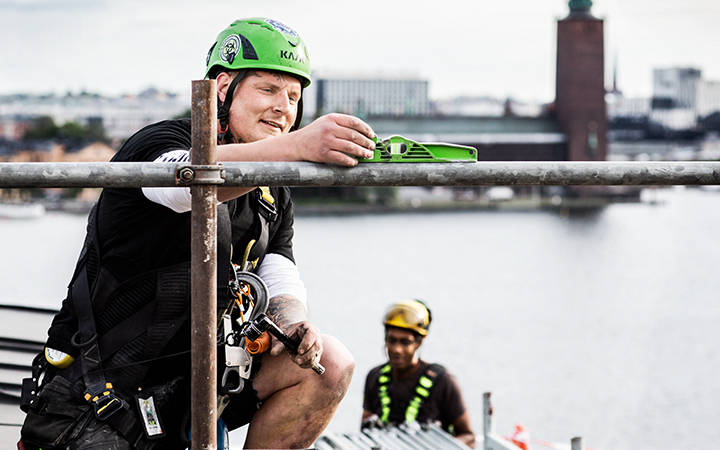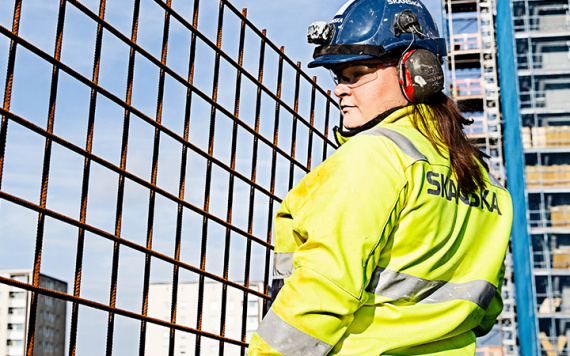Scaffolder
Climbing while building
A profession for those who are not afraid of heights! As a scaffolder, you have a skilled profession that requires meticulous work and working at heights.
What does a Scaffolder do?
You assemble the scaffolding needed by the various professionals on the site. Being safety-minded and precise work are very important parts of the job. The scaffolding must be able to withstand loads from storing materials to working, standing and walking on it.
There are different types of scaffolding, and the type used depends on the type of job to be done. A simple painting job requires one type of scaffolding, while a different type is needed if building materials such as bricks have to be lifted onto the scaffolding. Today mostly light metal scaffolding is used.
Good physical condition helps, but most important of all is using the right work methods. Scaffolding is subject to stringent safety requirements. The safety requirements are set forth in specific regulations.

How can I become a Scaffolder in secondary school?
You choose the building and construction programme and specialise in building construction. This provides your basic training.
The secondary school programme
In the first year, you study parts of the common secondary school subjects and the specific subjects that are common to the programme. The specific subjects of Building and Construction 1 and 2 provide you with knowledge and orientation in the different professions in the sector to better help you choose which one suits you best.
The programme combines theoretical and practical training in school with workplace-based learning (WBL). You must have at least 15 weeks of work-based learning during your training period. You can also complete your studies as a secondary school apprentice.
Qualification for higher education
As of August 2023 all programmes will be university preparatory programmes.
Qualification time
The period following initial training is called the qualification period. You work as an apprentice in a company during this time. The qualification period for a Scaffolder is 30 months, after which you can apply for a professional certificate. You will receive an agreed-upon apprenticeship wage during the qualification period. You must independently apply for an apprenticeship position in a company with a collective agreement or a labour contract.
How can I become a Scaffolder via adult education?
As an adult there are several ways to become a professional construction worker. You can choose to go either via the building and construction programme at VUX (secondary school for adults) or vacational advancement via the Employment Service. You can also choose to go thru an educational company. There are many opportunities as you can see!
The adult education programme
There are two paths: the School programme and the Adult education apprenticeship system.
The school programme is very similar to the secondary school programme. However, you only study vocational courses. The programme combines theoretical and practical education in school with training at the workplace, known as workplace-based learning (WBL). Roughly 15% of the total time is spent during workplace-based learning. The length of the programmes varies slightly but is usually one year. The length of the education period depends on the pace of the education, the choice of profession and the school’s own programme.
The majority of your training in the Adult education apprenticeship system (up to 70%) is at a workplace. Theoretical training is provided in the classroom. The length of the programmes varies slightly but is usually one year. The length of the education period depends on the pace of the education, the choice of profession and the school’s own programme.
Qualification time
The period following initial training is called the qualification period. You work as an apprentice in a company during this time. The qualification period for a Scaffolder is 30 months, after which you can apply for a professional certificate. You will receive an agreed-upon apprenticeship wage during the qualification period. You must independently apply for an apprenticeship position in a company with a collective agreement or a labour contract.
How can I become a Scaffolder as a company apprentice?
You must first find a company that wants to hire you as an apprentice.
Being a company apprentice means that you have a position as an apprentice but that you do lack some or all of an approved basic education and must now obtain this in the company. The programme has two parts, a theoretical and a practical part, which are studied in parallel.
The practical part is based on the qualifications for the respective profession and where you as an apprentice must achieve a certain degree of independence in each qualification. These must also be approved by your assigned supervisor.
You have 12 months to complete both the theoretical and practical parts of your basic training. Once this is completed and your supervisor has approved all parts, you can start your qualification period.
The education is conducted by STIB.
The distance learning programme
The training package compiled by STIB satisfies all of the requirements of BYN and the Swedish Work Environment Authority for theoretical training as a scaffolder.
The training package includes the following courses:
- Introductory training
This course includes: safe lifting, fall protection and ergonomics. - Professional section 1 – General training
This course leads to the General scaffolding training qualification.
To become a scaffolder, you must complete the General scaffolding training qualification within six months of starting. This training gives you the right to assemble scaffolding up to nine metres (four levels) IF the design is fully described in general assembly instructions, i.e. the design must not deviate from the description in the assembly instructions. The period following initial training is called the qualification period. You work as an apprentice in a company during this time. The qualification period for scaffolders is 30 months, after which you can apply for a professional certificate. You will receive an agreed-upon apprenticeship wage during the qualification period. You must independently apply for an apprenticeship position in a company with a collective agreement or labour contract.


